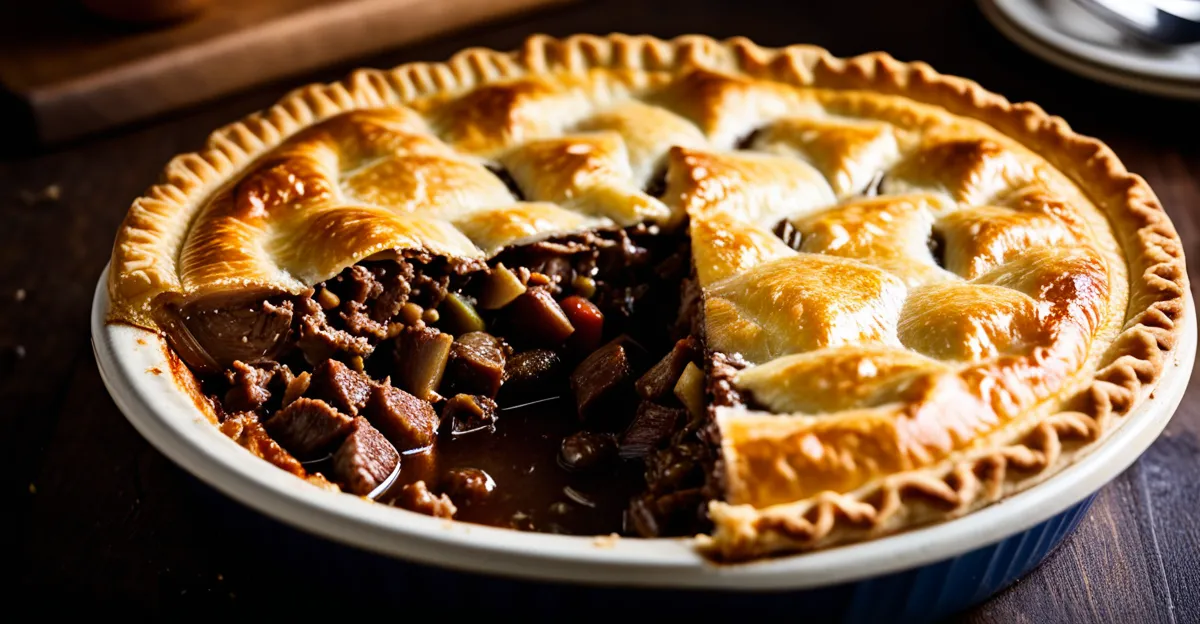Essential Ingredients and Quantities
Understanding the steak and kidney pie ingredients is fundamental for crafting a traditional British pie recipe. The core components include steak, kidney, onion, stock, flour, and seasonings. For a standard serving, the typical beef and kidney proportions are around 300g of diced steak to 150g of kidney. This balance ensures the filling has robust texture and flavour without overwhelming off-notes from kidney.
When selecting the kidney, choices typically range between beef, lamb, or pork. Beef kidney is firmer and has a stronger, earthier taste, ideal for those who enjoy pronounced flavours. Lamb kidney is milder and more tender, making it accessible for first-timers. Pork kidney is softer but can be more delicate in taste, so seasoning becomes crucial to avoid blandness.
Have you seen this : How Did Traditional UK Recipes Shape British Culinary Culture?
Onions add sweetness to complement the meat’s richness, usually one medium onion per pie. Stock—beef or vegetable—builds the base of the gravy, while flour thickens the filling. Seasonings like salt, pepper, and a touch of Worcestershire sauce enhance the overall depth. Using these ingredients in the right quantities guarantees a traditional, flavourful pie filling ready for baking.
Preparing the Steak and Kidney
Prepping steak and kidney properly is critical to achieving the desired texture and flavour in a traditional British pie recipe. Begin by trimming away any excess fat or sinew from the steak and kidney. For kidney, remove the outer membrane and any tough white cores; rinse under cold water to reduce any strong, earthy aroma. Cutting the meat into uniform, bite-sized pieces ensures even cooking.
Topic to read : How can you create a delicious bubble and squeak with leftovers?
Marinating the meat is highly recommended for tenderising and flavour enhancement. A simple marinade with red wine, Worcestershire sauce, or a splash of vinegar can soften the fibres and add depth. Aim to marinate for at least one hour, or overnight when possible, to let the flavours penetrate.
Seasoning before cooking is just as important. Lightly salt and pepper the meat prior to browning to enhance taste and aid in developing a rich crust. Attention to these preparation steps—cleaning, trimming, marinating, and seasoning—creates a base for a well-balanced steak and kidney pie filling that is tender and flavourful through every mouthful.
Browning the Meat and Developing Flavour
Browning meat for pies is a crucial step in creating a rich pie filling. To brown steak and kidney evenly, start by heating a heavy-based pan until very hot. Add the meat in small batches to avoid overcrowding, which causes steaming instead of browning. Browning develops the Maillard reaction, deepening flavour and texture critical for a traditional British pie recipe.
Simultaneously, sauté onions until translucent and gently caramelised. This layering of flavours balances the robust taste of the meat with a subtle sweetness, elevating the overall filling. After browning, deglaze the pan using a liquid—often stock or red wine—to loosen the fond, the browned residue on the pan’s base. Fond adds intense depth to the gravy and ties all ingredients together.
The combination of properly browned steak and kidney infused with caramelised onions and deglazing liquid forms the flavour backbone. This technique leverages beef and kidney proportions effectively, ensuring each bite of the pie is savoury and complex without bitterness or underdeveloped notes. Mastering this process results in a delicious, hearty filling that is essential for a memorable steak and kidney pie.
Making the Gravy and Pie Filling
Creating the steak and kidney pie gravy is essential for a rich, luscious filling that complements the browned meat perfectly. Begin by combining the browned steak and kidney with stock—beef stock works best for depth—or a robust vegetable alternative. To thicken the pie filling, use flour, which should be sprinkled over the meat before adding the stock. This acts as a natural thickener, producing the classic pie sauce consistency prized in a traditional British pie recipe.
Simmer the mixture gently, allowing the meat to tenderise further while the flavours meld. A low and slow approach over 1–2 hours helps dissolve collagen in the steak, developing a succulence that defines an authentic pie. Regularly stir to prevent sticking and adjust seasoning with salt, pepper, and Worcestershire sauce for added umami.
Achieving the correct thickness is vital—too thin, and the filling spills; too thick, and it feels dry. The gravy should coat the meat but remain glossy and fluid. These steps ensure the beef and kidney proportions are balanced within a classic, savoury gravy that unites all elements of the pie filling.
Choosing and Preparing the Pastry
Selecting the right steak and kidney pie pastry is crucial for an authentic British pie experience. Traditional options include shortcrust and puff pastry. Shortcrust offers a sturdy, crumbly base that holds the hearty filling well, while puff pastry provides a light, flaky top enhancing texture contrast in the classic pie. Understanding the qualities of each guides your choice for the desired mouthfeel and appearance in a traditional British pie recipe.
When making pastry from scratch, precise ratios of butter to flour help achieve the right consistency—cold butter and minimal handling prevent toughness. Alternatively, high-quality ready-made pastry can save time without compromising flavour or texture. Rolling pastry evenly and to the correct thickness ensures it cooks uniformly; too thick leads to doughiness, too thin risks breaking.
Fitting the pastry into the pie dish requires care to avoid stretching, which causes shrinkage while baking. Allow a small overhang for a secure seal when adding the pastry lid. Handling the pastry with lightly floured hands helps maintain its integrity throughout assembly.
Mastering classic pie crust tips complements the rich filling, creating a balanced, appealing steak and kidney pie that pleases both the eye and palate.







